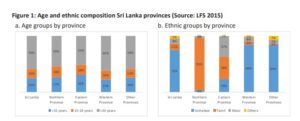by David Locke Newhouse & An Rudra Silwal, World Bank, Washington, DC, February 26, 2018
Policy Research working paper; no. WPS 8355
World Bank WPS8355 State of Jobs in Post Conflict Areas
ABSTRACT
Although Sri Lanka has made significant progress in social and economic development over the past decade, the Northern and Eastern provinces that faced the brunt of the decades-long conflict remain disproportionately poor. To understand the labor market dimensions of poverty in these regions, this paper examines a range of job-related indicators, using data from 2011 to 2015. The overall labor force participation rate in these provinces is significantly lower than in the rest of the country. Much of the difference can be attributed to adult women, although the participation rates of youth and those with lower educational attainment are also low. The distribution of wages for male and female wage workers in these provinces is similar to that in other parts of the country. The pattern of low employment rates and comparable wages is consistent with a combination of low demand for labor and greater reluctance to work in these regions, which each depress employment but have counteracting effects on equilibrium wages. Skills are an issue, as adults in these provinces tend to score lower on literacy tests and have lower self-reported skills in reading, writing, and numeracy. Households in these provinces have less access to formal finance, which may also contribute to a lack of self-employment opportunities.

This is the first study we are aware of that examines multiple, complementary aspects of the labor market in a post‐conflict setting. This paper is organized as follows. The next section summarizes a variety of job-related outcomes in the Northern and Eastern Provinces compared with the Western and other provinces. It identifies low rates of labor force participation of women in particular, as well as youth, as distinctive features of the labor markets in these provinces. The following section examines in detail which types of workers and jobs are missing in these regions as compared with the rest of the country. Section 4 examines selected potential demand and supply factors that may explain these low rates of labor force participation of women and youth. Section 5 provides a summary and concluding thoughts.